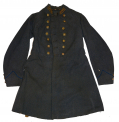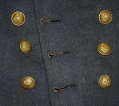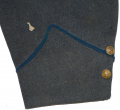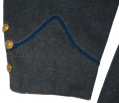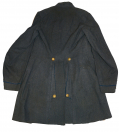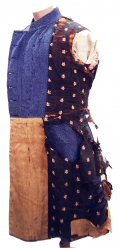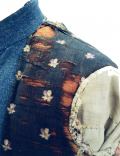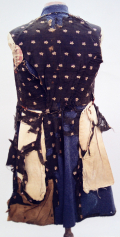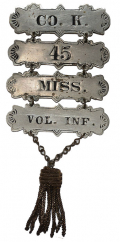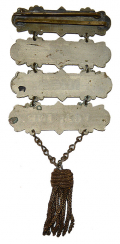site search
online catalog
IDENTIFIED CONFEDERATE CAPTAIN’S FROCK COAT OF CAPTAIN PHARES WALDO SHEARER, 45th MISSISSIPPI, WITH 28-PAGE REMINSCENCES AND VETERAN’S BADGE- HE EXCHANGED SALUTES WITH THE WOUNDED JOHN BELL HOOD AT CHICKAMAUGA
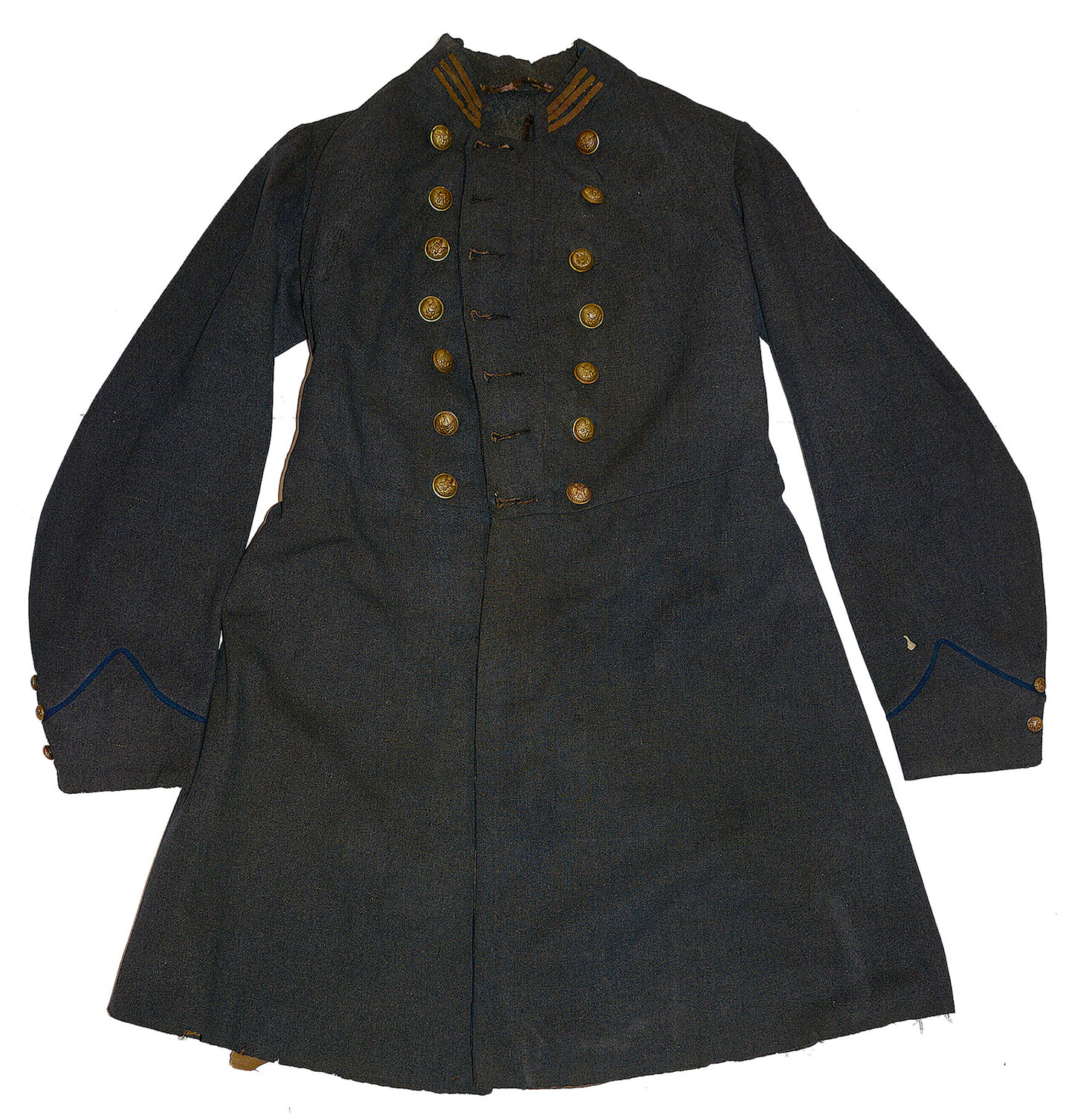
$45,000.00
Quantity Available: 1
Item Code: 1179-179
Shipping: Determined by Method & Location of buyer
To Order:
Call 717-334-0347,
Fax 717-334-5016, or E-mail
This coat came directly out of the family along with a reunion badge and type-written copy of the officer’s 1906 reminiscences. The coat was formerly in the collection of Steve Mullinax, is accompanied by a file containing details of its acquisition from the officer’s great granddaughter by a previous collector, and was lately in the collections of the Texas Civil War Museum. The coat also comes with a 2001 thee-page letter from Confederate uniform authority Les Jensen containing textile analysis and history of the original owner, that will be supplied to interested parties.
The coat is double-breasted, made of dark, cadet gray cloth with 1 ½ inch standing collar bearing the three gold braid rank bars of a captain. The sleeves have a nice 7 ½ inch billow at the elbows, omit the galloons, but are are piped in infantry royal blue on cuff, as are the top of the collar and tails. Buttonholes on the breast show stretching from long use, but are intact. The coat buttons are large US general staff buttons. The cuffs are smaller US Navy. One cuff button is missing. There is one interior breast pocket and two tail pockets accessible from the inside. The sleeves are lined in white. The body has a great, floral print black lining reinforced in places with a brown cotton. The lining is ragged in sections, shows some patching, and missing large sections in the skirts, all of which wear, like the stretching of the buttonholes, is commensurate with the owner’s long service record. Aside from some few moth nips and some fading to the piping on the skirts and collar, however, the only defect visible on the exterior is a 1 by 2 inch rectangle on the wearer’s right breast that seems to have been torn and resewn, but with no fabric missing.
The coat was worn by Captain Philo Waldo Shearer, who saw extensive service in the western theatre as private, sergeant, first sergeant, sergeant major, quartermaster sergeant, and captain and quartermaster at the regimental and brigade level in the Army of Mississippi and the Army of Tennessee. The coat comes with his Confederate veteran’s regimental ladder badge reflecting his membership in Co. K of the 45th Mississippi before his elevation to Quartermaster, reading “CO. K / 45 / MISS. / VOL INF.,” with pinback top bar and small gold bullion knot and tassels at the bottom, suspended by a chain. Also with the coat is a 28-page typescript copy of Shearer’s reminiscences. These were originally set down in 1906 and supporting material refers to the typed copy having been made at the behest of a descendent, apparently while that branch of the family lived in New York.
The coat likely dates to Shearer’s promotion to Captain in December 1862. He did several tours of duty throughout the war. A well-off merchant in Raymond, MS, he enlisted first in April 1861 as a private in the 12th Mississippi, but as a married man with wife and daughters, he was asked to step aside for eager, young single men. He reenlisted in Fall 1861 joining the “Raymond Minute Men,” who became part of the 1st Miss. State Troops in a call for troops to aid Polk in Kentucky, being made First Sergeant and eventually Sergeant Major. The unit campaigned during the winter and suffered heavily from sickness and disease. Shearer was discharged for sickness January 1, 1862, was invalided at his father’s home in Okalona, MS, until April. He signed up once again in June 1862, in a new company of volunteers from Raymond, “The Charleton Rebels,” which became Co. K of 33rd Mississippi, soon redesignated as the 45th Mississippi, assigned to Wood’s brigade in Hindman’s, then Buckner’s division. Shearer recounts efforts at training and discipline in the summer of 1862, including the shooting of deserters. In the campaign into Kentucky that Fall, the regiment was in Buckner’s division, and Shearer regimental Quartermaster Sergeant, marching on foot with the trains until they reached Bardstown, where he was promoted which led to commission on Dec. 1, 1862, as Captain and Assistant Quartermaster in the Confederate Army, with commission dating to Dec. 1, 1862, and posting to the 45th Mississippi with a date of rank of October 14, likely the date he took up the duties.
The regiment fought at Mumfordsville, where he went over the field with a cousin in the 41st MS, and then at Perryville, where he recorded gathering material from the field and losses to his old company from Union artillery. He was on detached duty for a short time afterward, gathering supplies, but was back with the regiment in time for Murfreesboro, where Cleburne commanded the division, and about half of his old company were captured, though exchanged soon after. At Chickamauga Shearer recounts not on the devastation he saw on the field and his efforts bright supplies up to field hospitals, but encountering General Hood who, though being carried to the rear seriously wounded, nevertheless exchanged salutes with Shearer, who driving supply trains forward.
Shearer saw further action at Chattanooga, Missionary Ridge, and in the Atlanta Campaign, having been promoted Brigade Quartermaster in May 1864. Although he had praise for Hood in the context of southern soldiers in general, he regarded Hood’s replacement of Johnston as a turning point toward disaster with the fighting around Atlanta and the ruinous assault at Franklin.
Shearer writes that he had lost hope in the cause by the end of the war and had submitted his resignation with a view to signing up to fight as an enlistedman, which he notes was done by many officers left without commands from their severe losses, but records indicate he was still on duty and with the Army of Tennessee supply trains when Johnston surrendered on April 26 and was paroled May 3 at Charlotte.
Shearer’s reminiscences include many references to relatives in the service and some details of his comrades in his old company, visits from his wife, attempts to visit home, and the loss of two children. He emphasized the destruction he witnessed in the countryside and had no good words for Sherman, though he maintained McPherson’s death was regretted because of his kind treatment of civilians. He wrote down his recollections for his descendants and hopes they will read enough about the causes of the war, in his view at least, to acquit him of charges of treason and rebellion. He has no good words about Reconstruction. His only reference to slavery involves two black men who accompanied him in the service, or at least part of it, praising their loyalty and dislike of yankees, but never clarifying their status. One served as hostler, managing his horses, etc., and the other as a cook, whom he mentions “hiring to his mess,” implying Shearer was his owner and hired out his services to his officer’s mess. At the end of the fighting Shearer returned to Mississippi and business as a merchant, living until 1914, with his regimental badge indicating he was active in veterans’ affairs. He died in 1914.
This is a great looking coat with tight documentation to a Confederate officer with active service in the western theatre with the additional advantage of his own lengthy personal account of his service. [sr][ph:L]
~~~~~~~~~~~~~~~~~~~~~~~~~~~~~~~~~~~
THIS ITEM, AS WITH ALL OTHER ITEMS AVAILABLE ON OUR WEB SITE,
MAY BE PURCHASED THROUGH OUR LAYAWAY PROGRAM.
CLICK HERE FOR OUR POLICIES AND TERMS.
THANK YOU!
Inquire About IDENTIFIED CONFEDERATE CAPTAIN’S FROCK COAT OF CAPTAIN PHARES WALDO SHEARER, 45th MISSISSIPPI, WITH 28-PAGE REMINSCENCES AND VETERAN’S BADGE- HE EXCHANGED SALUTES WITH THE WOUNDED JOHN BELL HOOD AT CHICKAMAUGA
For inquiries, please email us at [email protected]
Most Popular
Historical Firearms Stolen From The National Civil War Museum In Harrisburg, Pa »
Theft From Gravesite Of Gen. John Reynolds »
Selection Of Unframed Prints By Don Troiani »
Fine Condition Brass Infantry Bugle Insignia »
British Imported, Confederate Used Bayonet »
Scarce New Model 1865 Sharps Still In Percussion Near Factory New »
featured item
US MODEL 1860 AMES CAVALRY OFFICER’S SABER WITH WOOD LINED STEEL SCABBARD
Manufactured: Chicopee, Mass. Maker: Ames Mfg. Co. Year: Civil War Model: M1860 Size: 35 inch blade Condition: Excellent+ This regulation M1860 Cavalry Officer has the decorated guard with the eagle, decorated branches and pommel. The grip is… (870-122). Learn More »
site search
Upcoming Events
May 16 - 18: N-SSA Spring Nationals, Fort Shenandoah, Winchester, VA Learn More »



